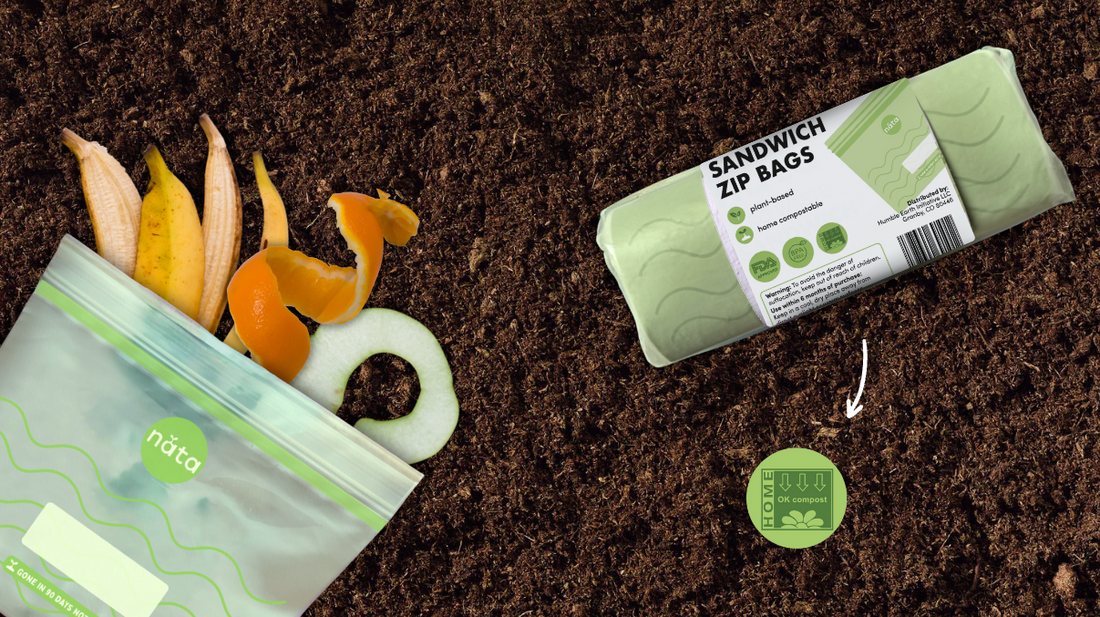
Home composting, made easy with Nata
Share
In the US, only 6% of Americans compost their kitchen scraps, the rest ends up in the trash and eventually into landfills. That’s roughly 400 pounds of trash per household every, single year - which translates into about 35% of the total U.S. food supply ending up in the trash, according to ReFED, a California-based nonprofit organization dedicated to ending food waste.
 That is where composting comes in! Composting is nature’s way of recycling. It is a natural process of breaking down organic matter such as food scraps and yard waste (trimmings, wood chips, mulch, etc) that results in rich, nutrient soil amendment - basically the best natural fertilizer for your plants!
That is where composting comes in! Composting is nature’s way of recycling. It is a natural process of breaking down organic matter such as food scraps and yard waste (trimmings, wood chips, mulch, etc) that results in rich, nutrient soil amendment - basically the best natural fertilizer for your plants!
So let’s start home composting. You can do either of the two things (1) Gather food scraps and compostable waste to drop-off at a nearby compost collecting pile or (2) Starting and making your own pile.
If you’re the latter, then we loudly applaud you for taking THE step! You’ll never have a need for soil or fertilizer again. All you need are the following:
- Compost Bin or Container (breathable, access to light and water)
- Compostable Waste
- Knowing your Browns and Greens

And while it may seem daunting and confusing, all you have to do is start.
- Collect a scraps/waste pile to be composted. Have a good mix of “Browns” and “Greens” with a ratio of about 3:1 - some say 2:1 so start with 3 and adjust along the way if your pile looks “too dry”.
- Transfer to your compost bin and mix it all up. Mixing induces heat and facilitates the breakdown of the scraps.
- Make sure to add water to your pile - it should feel like a damp sponge. Water is indeed life, it feeds the microbes that are in then in-charge of decomposing your pile. Mix some more.
- How fast your scraps turn into compost depends on the effort you put in. Do you continuously add greens/browns? Do you constantly turn/mix it? Do you ensure consistent watering? We say, do it at your pace but don’t keep it stagnant for too long.
- Once scraps have completely decomposed (looks like dark soil). Harvest the compost and use as desired.
The longer you have your pile, the more in-tuned you are and can adjust accordingly along the way, so don’t stress about it. Some key tips:
- If pile looks dry - add more greens and moisture, turn/mix as often as possible
- If pile is starting to smell - add more browns
- Bugs are totally okay and normal!
- Make sure your pile gets good airflow and light
Finally, you’ve read “browns” and “greens” consistently in this article, so what are they exactly?

We find that variety is key in keeping a compost “alive” and happy! So if there’s a reason to start eating more seasonal produce then this is it - this will ensure variety on what ends up on your pile.
Nata products are 100% Certified Home Compostable, meaning it has been tested and cleared to be capable of being composted at home. Simply throw into your compost pile after use and will decompose together with your other scraps and waste.
For everyday digestible content, please follow @nataforall on Instagram or join our Nata Community on Facebook - The Nata World. See you there 🌸
Source:
